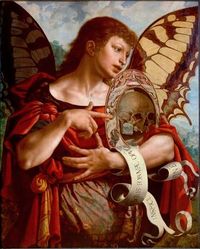Vanity
Vanity is the excessive belief in one's own abilities or attractiveness to others. Prior to the 14th century, it did not have such narcissistic undertones and merely meant futility. The related term vainglory is now often seen as an archaic synonym for vanity, but originally meant considering one's own capabilities and that God's help was not needed, i.e. unjustified boasting; although glory is now seen as having a predominantly positive meaning, the Latin term from which it derives, Gloria, roughly means boasting and was often used as negative criticism.
Symbolism
In Western art, vanity was often symbolized by a peacock, and in Biblical terms, by "The Whore of Babylon". During the Renaissance, vanity was invariably represented as a naked woman, sometimes seated or reclining on a couch. She attends to her hair with a comb and a mirror. The mirror is sometimes held by a demon or a putto. Symbols of vanity include jewels, gold coins, a purse, and the figure of death.
Some depictions of vanity include scrolls that read Omnia Vanitas ("All is Vanity"), a quotation from the Latin translation of the biblical Book of Ecclesiastes. Although the term vanitas (Latin, "emptiness") originally meant not obsession by one's appearance, the ultimate fruitlessness of humankind's efforts in this world, the phrase summarizes the complete preoccupation of the subject of the picture.
"The artist invites us to pay lip service to condemn her," writes Edwin Mullins, "while offering us full permission to drool over her. She admires herself in the glass, while we treat the picture that purports to incriminate her as another kind of glass—a window—through which we peer and secretly desire her." The theme of the recumbent woman often merged artistically with the non-allegorical one of a reclining Venus.
In his table of the Seven deadly sins, Hieronymus Bosch depicts a bourgeois woman admiring herself in a mirror held up by a devil; behind her is an open jewelry box. A painting attributed to Nicolas Tournier, which hangs in the Ashmolean Museum, is An Allegory of Justice and Vanity: a young woman holds a balance, symbolizing justice; she does not look at the mirror or the skull on the table before her. Johannes Vermeer's painting Girl with a Pearl Earring is sometimes believed to depict the sin of vanity because the young girl has adorned herself before a glass without further positive allegorical attributes.
All is Vanity, by Charles Allan Gilbert (1873–1929), carries on this theme. An optical illusion, the painting depicts what appears to be a large grinning skull. Upon closer examination, it reveals itself to be a young woman gazing at her reflection in the mirror. In the film The Devil's Advocate, Satan (Al Pacino) claims that "vanity is his favorite sin".
Such artistic works served to warn viewers of the ephemeral nature of youthful beauty, as well as the brevity of human life and the inevitability of death.
In the RPG game Persona 5, the second target Ren Amamiya and his friends have to change the heart of is Ichiryusai Madarame, an artist that plagiarises his students' work and abuses them as well, with one of his students committing suicide over his actions. He is represented by Vanity as his Palace is an art museum filled with plagiarised work.
See also [ Narcissism ]
Chat rooms • What links here • Copyright info • Contact information • Category:Root
